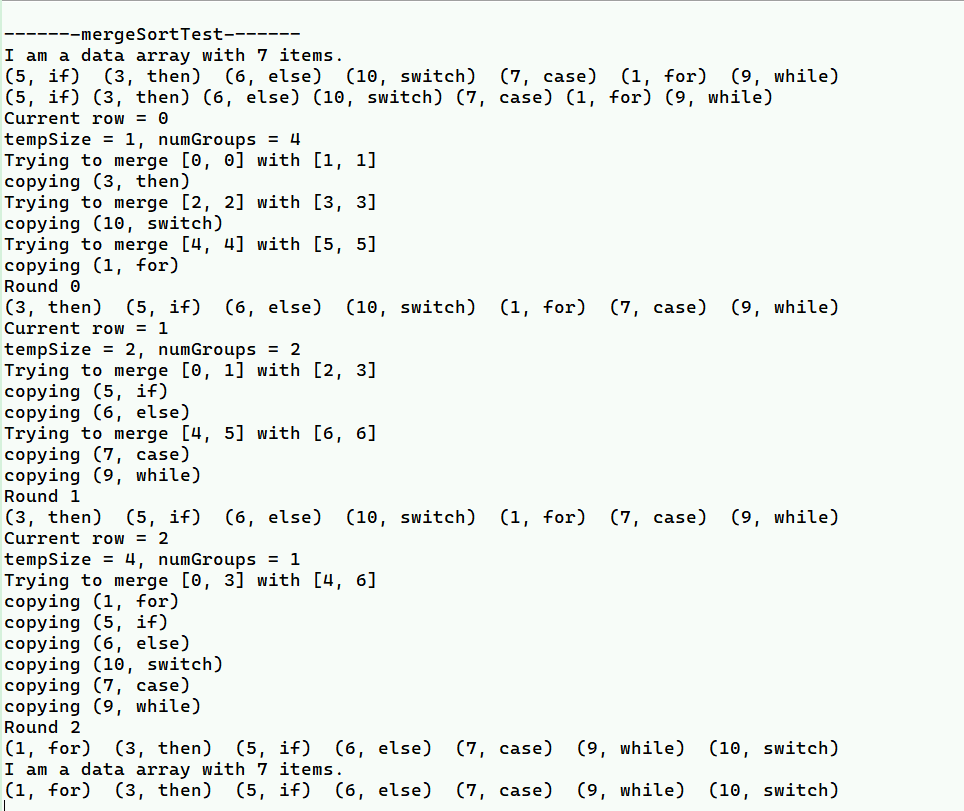学习来源:日撸 Java 三百行(41-50天,查找与排序)_闵帆的博客-CSDN博客
文章目录
归并排序
一、描述
归并排序(Merge sort)是建立在归并操作上的一种有效、稳定的排序算法, 该算法是采用分治法(Divide and Conquer)的一个非常典型的应用. 将已有序的子序列合并, 得到完全有序的序列
即先使每个子序列有序, 再使子序列段间有序. 若将两个有序表合并成一个有序表, 称为二路归并.
log n \log n logn轮, 每轮 O ( n ) O(n) O(n) 次拷贝. 因此时间复杂度为 O ( n log n ) O(n\log n) O(nlogn)
空间复杂度为 O ( n ) O(n) O(n). 只需要一行辅助空间.
归并排序适用于数据量大, 并且对稳定性有要求的场景.
二、具体代码
/**
*********************
* Merge sort. Results are stored in the member variable data.
*********************
*/
public void mergeSort() {
// Step 1. Allocate space.
int tempRow; // The current row
int tempGroups; // Number of groups
int tempActualRow; // Only 0 or 1
int tempNextRow = 0;
int tempGroupNumber;
int tempFirstStart, tempSecondStart, tempSecondEnd;
int tempFirstIndex, tempSecondIndex;
int tempNumCopied;
for (int i = 0; i < length; i++) {
System.out.print(data[i]);
} // Of for i
System.out.println();
DataNode[][] tempMatrix = new DataNode[2][length];
// Step 2. Copy data.
for (int i = 0; i < length; i++) {
tempMatrix[0][i] = data[i];
} // Of for i
// Step 3. Merge. log n rounds
tempRow = -1;
for (int tempSize = 1; tempSize <= length; tempSize *= 2) {
// Reuse the space of the two rows.
tempRow++;
System.out.println("Current row = " + tempRow);
tempActualRow = tempRow % 2;
tempNextRow = (tempRow + 1) % 2;
tempGroups = length / (tempSize * 2);
if (length % (tempSize * 2) != 0) {
tempGroups++;
} // Of if
System.out.println("tempSize = " + tempSize + ", numGroups = " + tempGroups);
for (tempGroupNumber = 0; tempGroupNumber < tempGroups; tempGroupNumber++) {
tempFirstStart = tempGroupNumber * tempSize * 2;
tempSecondStart = tempGroupNumber * tempSize * 2 + tempSize;
if (tempSecondStart > length - 1) {
// Copy the first part.
for (int i = tempFirstStart; i < length; i++) {
tempMatrix[tempNextRow][i] = tempMatrix[tempActualRow][i];
} // Of for i
continue;
} // Of if
tempSecondEnd = tempGroupNumber * tempSize * 2 + tempSize * 2 - 1;
if (tempSecondEnd > length - 1) {
tempSecondEnd = length - 1;
} // Of if
System.out.println("Trying to merge [" + tempFirstStart + ", " + (tempSecondStart - 1) + "] with ["
+ tempSecondStart + ", " + tempSecondEnd + "]");
tempFirstIndex = tempFirstStart;
tempSecondIndex = tempSecondStart;
tempNumCopied = 0;
while ((tempFirstIndex <= tempSecondStart - 1) && (tempSecondIndex <= tempSecondEnd)) {
if (tempMatrix[tempActualRow][tempFirstIndex].key <= tempMatrix[tempActualRow][tempSecondIndex].key) {
tempMatrix[tempNextRow][tempFirstStart
+ tempNumCopied] = tempMatrix[tempActualRow][tempFirstIndex];
tempFirstIndex++;
System.out.println("copying " + tempMatrix[tempActualRow][tempFirstIndex]);
} else {
tempMatrix[tempNextRow][tempFirstStart
+ tempNumCopied] = tempMatrix[tempActualRow][tempSecondIndex];
System.out.println("copying " + tempMatrix[tempActualRow][tempSecondIndex]);
tempSecondIndex++;
} // Of if
tempNumCopied++;
} // Of while
while (tempFirstIndex <= tempSecondStart - 1) {
tempMatrix[tempNextRow][tempFirstStart + tempNumCopied] = tempMatrix[tempActualRow][tempFirstIndex];
tempFirstIndex++;
tempNumCopied++;
} // Of while
while (tempSecondIndex <= tempSecondEnd) {
tempMatrix[tempNextRow][tempFirstStart
+ tempNumCopied] = tempMatrix[tempActualRow][tempSecondIndex];
tempSecondIndex++;
tempNumCopied++;
} // Of while
} // Of for groupNumber
System.out.println("Round " + tempRow);
for (int i = 0; i < length; i++) {
System.out.print(tempMatrix[tempNextRow][i] + " ");
} // Of for j
System.out.println();
} // Of for tempStepSize
data = tempMatrix[tempNextRow];
}// Of mergeSort
/**
*********************
* Test the method.
*********************
*/
public static void mergeSortTest() {
int[] tempUnsortedKeys = {
5, 3, 6, 10, 7, 1, 9 };
String[] tempContents = {
"if", "then", "else", "switch", "case", "for", "while" };
DataArray tempDataArray = new DataArray(tempUnsortedKeys, tempContents);
System.out.println(tempDataArray);
tempDataArray.mergeSort();
System.out.println(tempDataArray);
}// Of mergeSortTest
三、运行截图

四、总结
相比起通过循环来实现归并排序, 使用递归的形式仿佛更容易实现.
小结
一、各大查找算法对比
| 查找算法 | 复杂度 |
|---|---|
| 顺序查找 | O ( n ) O(n) O(n) |
| 二分查找 | O ( n log n ) O(n\log n) O(nlogn) |
| 哈希查找 | O ( 1 ) O(1) O(1) (无冲突的情况下) |
二、设计一个自己的 Hash 函数和一个冲突解决机制.
1. Hash 函数
找一个素数用于取模.
2. 冲突解决机制
采用链地址法, 当发生冲突时将冲突元素组织成为一个链表.
三、各大排序算法对比
| 排序算法 | 平均时间复杂度 | 空间复杂度 | 稳定性 |
|---|---|---|---|
| 插入排序 | O ( n ) O(n) O(n) | O ( 1 ) O(1) O(1) | 稳定 |
| 希尔排序 | O ( n log n ) O(n\log n) O(nlogn) | O ( 1 ) O(1) O(1) | 不稳定 |
| 冒泡排序 | O ( n 2 ) O(n^2) O(n2) | O ( 1 ) O(1) O(1) | 稳定 |
| 快速排序 | O ( n log n ) O(n\log n) O(nlogn) | O ( log n ) O(\log n) O(logn) | 不稳定 |
| 选择排序 | O ( n 2 ) O(n^2) O(n2) | O ( 1 ) O(1) O(1) | 不稳定 |
| 堆排序 | O ( n log n ) O(n\log n) O(nlogn) | O ( 1 ) O(1) O(1) | 不稳定 |
| 归并排序 | O ( n log n ) O(n\log n) O(nlogn) | O ( n ) O(n) O(n) | 稳定 |
四、描述各种排序算法的特点和基本思想.
插入排序是每趟排序把元素插入到已排好序的数组中. 特点是稳定, 第 k 次排序后, 前 k 个元素已经是从小到大排好序的.
希尔排序是基于插入排序的一种排序算法, 思想是对长度为 n 的数组 s , 每趟排序基于间隔 h 分成几组, 对每组数据使用插入排序方法进行排序, 然后减小 h 的值, 这样刚开始时候虽然分组比较多, 但每组数据很少, h 减小后每组数据多但基本有序, 而插入排序对已经基本有序的数组排序效率较高.
冒泡排序思想很简单, 就是对每个下标 i, 取 j 从 0 到 n-1-i (n是数组长度)进行遍历. 如果两个相邻的元素 s[j] > s[j+1], 就交换, 这样每次最大的元素已经移动到了后面正确的位置.
快速排序是内排序中平均性能较好的排序, 思想是每趟排序时选取一个数据(通常用数组的第一个数)作为关键数据, 然后将所有比它小的数都放到它的左边, 所有比它大的数都放到它的右边. 特点是不稳定, 递归还容易栈溢出.
选择排序思想是对每个下标 i, 从 i 后面的元素中选择最小的那个和 s[i] 交换. 选择排序的特点: 不稳定, 每趟排序后前面的元素肯定是已经排好序的了, 每次排序后可以确定一个元素会在其最终位置上.
堆排序是基于选择排序的一种排序算法, 堆是一个近似完全二叉树的结构, 且满足子结点的键值或索引总是小于(或者大于)它的父节点. 代码中采用最大堆方式: 位于堆顶的元素总是整棵树的最大值, 每个子节点的值都比父节点小, 堆要时刻保持这样的结构, 所以一旦堆里面的数据发生变化, 要对堆重新进行一次构建.
归并排序的思想是将两个有序表合并成一个新的有序表, 即把待排序序列分为若干个子序列, 每个子序列是有序的. 然后再把有序子序列合并为整体有序序列. 即先划分为两个部分, 最后进行合并. 特点是稳定, 可以用在顺序存储和链式存储的结构.